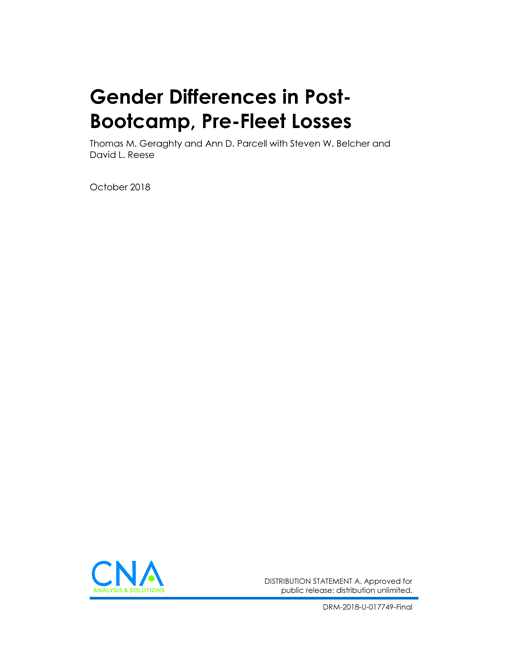The female share of Navy accessions has increased over the last several decades. Women’s entry qualifications have increased over that time as well; however, there still appear to be barriers to female representation in the Navy inventory. Historically, for example, women in the Navy have retained at lower rates than men, and they have continued to do so to the present. Depending on the rating, female retention rates to the second term (i.e., after four to six years of service) are anywhere from 5 to 75 percent lower than those of their male counterparts.
This research memorandum is part of a larger CNA project sponsored by the Office of the Assistant Secretary of the Navy (Financial Management and Comptroller) (ASN (FM&C)) that is intended to explore cost-effective ways to maintain or even improve retention. This is of particular interest as the female share of accessions continues to rise. Here, we examine one specific driver of female representation in the inventory: female-male differences in post-bootcamp, pre-fleet losses from the Navy. During this part of their careers, accessions are undergoing rating-specific training.
We focus in particular on highly technical ratings requiring high ASVAB scores for entry and having long training pipelines because these Sailors are the most expensive to recruit and train. Using data from CNA’s Enlisted Street-to-Fleet database and other sources, we find that in such ratings as the Advanced Electronics and Computer Field (AECF), the Nuclear Field (NF), and some Cryptologic Technician (CT) fields, female loss rates after bootcamp but before reaching the fleet have exceeded those of men by 50 to 100 percent or more fairly consistently since the 1990s. The matter of higher female loss rates is not a general issue across the Navy but is instead concentrated in these highly technical ratings, and the differences persist even after controlling for other factors that might be associated with losses, such as test scores. Using data on loss codes, we find that women who leave the Navy after bootcamp but before going to the fleet are more likely than men to be assigned codes associated with health (physical and mental) or family issues, such as “Medical,” “Pregnancy,” or “Parenthood.” Male losses are more likely to be assigned codes associated with behavioral issues, including “Drugs,” “Alcohol,” “In lieu of court martial (CM),” and “Other misconduct.” With respect to reenlistment quality codes (RQCs), female attriters are more likely to be assigned the “Parent,” “Physical disability,” or “Condition” codes (indicating a personality or other condition, such as fear of flying, that does not rise to the level of a disability but does impair a person’s ability to perform military tasks) in technically advanced fields. This evidence suggests that misbehavior is not driving higher female losses from the post-bootcamp, pre-fleet training pipeline in these fields. It is not a new finding that women leave the Navy in the first term for health or family[1]related reasons at higher rates than men. It is puzzling, however, that the higher rates of female losses occur after these recruits have completed bootcamp and almost exclusively in ratings requiring very high-test scores.
We conclude with a set of recommendations that, if adopted, would provide the Navy with a deeper understanding of exactly why we see higher female attrition in certain ratings compared with their male counterparts:
- Review the loss code assignment process.
- Take steps to better understand differences in women’s and men’s experiences in the training pipeline, including analyzing existing or newly developed exit interviews or surveys that ask servicemembers about their reasons for leaving and about their experiences during training.
- Review decision-making processes that determine how Sailors who are experiencing problems in the training pipeline are identified and whether such Sailors are reassigned to new ratings.
DISTRIBUTION STATEMENT A. Approved for public release: distribution unlimited.
SPECIFIC AUTHORITY: N00014-16-D-5003 10/15/2018
Details
- Pages: 64
- Document Number: DRM-2018-U-017749-Final
- Publication Date: 10/1/2018
